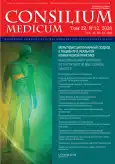Clinical-functional features and problems of rehabilitation in patients with osteoporosis of the elderly age in combination with accompanying pathology
- Authors: Dymnova S.E.1,2, Sergeeva V.V.1
-
Affiliations:
- Saint Petersburg Institute for Advanced Training of Medical Experts
- Hospital for Veterans of Wars
- Issue: Vol 22, No 12 (2020)
- Pages: 84-88
- Section: Articles
- URL: https://journals.rcsi.science/2075-1753/article/view/95417
- DOI: https://doi.org/10.26442/20751753.2020.12.200503
- ID: 95417
Cite item
Full Text
Abstract
Keywords
Full Text
##article.viewOnOriginalSite##About the authors
Svetlana E. Dymnova
Saint Petersburg Institute for Advanced Training of Medical Experts; Hospital for Veterans of Wars
Email: svetadymnova@ram bler.ru
аспирант каф. терапии, медико-социальной экспертизы и реабилитации Санкт-Петербург, Россия
Vera V. Sergeeva
Saint Petersburg Institute for Advanced Training of Medical Expertsд-р мед. наук, проф., зав. каф. терапии, медико-социальной экспертизы и реабилитации Санкт-Петербург, Россия
References
- Алексеева Л.И., Баранов И.А. и др. Клинические рекомендации по профилактике и ведению больных с остеопорозом. Издание 2-е, доп. Под ред. проф. О.М. Лесняк. Российская ассоциация по остеопорозу. Ярославль: Литера,2014.
- Беневоленская Л.И., Лесняк О.М. Остеопороз: диагностика, профилактика и лечение. Клинические рекомендации Российской ассоциации по остеопорозу. М.: ГЭОТАР-Медиа, 2017.
- Беневоленская Л.И. Проблема остеопороза в современной медицине. Consilium Medicum. 2004; 6 (2).
- Гарднер Д., Шобек Д. Базисная и клиническая эндокринология. Кн. 2. М.: БИНОМ, 2011; с. 424-35.
- Дедов И.И., Мельниченко Г.А. Эндокринология: национальное руководство. М.: ГЭОТАР-Медиа, 2009; с. 757-817.
- Ершова О. Б. Комментарии к практическому использованию российских клинических рекомендаций по остеопорозу. Остеопороз и остеопатии. 2010; 1: 34-47.
- Зоткин Е.Г., Косульникова Е.Н. Остеопороз: от организации помощи больным к лечению. Медлайн экспресс. 2007; 1 (190): 56-9.
- Зоткин Е.Г., Хурцилава О.Г., Зубкова И.И., Сафонова Ю.А. Вертебральные и периферические остеопоротические переломы: диагностика и медико-социальная значимость. Травматология и ортопедия России. 2010; 2 (56): 106-9.
- Зубкова И.И. Медико-социальные и экономические последствия остеопоротических переломов среди взрослого населения Санкт-Петербурга. Автореф. дис.. канд. мед. наук. СПб., 2013.
- Иванов С.Н., Кочиш А.Ю., Санникова Е.В. Опыт создания службы вторичной профилактики остеопоротических переломов костей в РНИИТО им. Р.Р. Вредена. Фарматека. 2015; 4 (15): 27-33.
- Коробкова М.В., Помникова В.Г. Справочник по медико-социальной экспертизе и реабилитации. СПб.: Гиппократ, 2010; c. 337-85.
- Лесняк О.М., Торопцова Н.В., Евстигнеева Л.П. Остеопороз. Профилактика и амбулаторное ведение пациентов. Методические рекомендации. М., 2013.
- Лесняк О.М. Аудит состояния проблемы остеопороза в Российской Федерации. Профилактическая медицина. 2018; 14 (2): 7-10.
- Косульникова Е.Н., Пушкова Е.С. Влияние осложненного сенильного остеопороза на качество жизни пожилых людей. Остеопороз и остеопатии. 2010; 1: 5-7.
- Михайлов Е.Е., Меньшикова Л.В., Ершова О.Б. Эпидемиология остеопороза и переломов в России. Материалы Рос. конгр. по остеопорозу (Москва, 20-22 октября 2003 г.). М., 2003; с. 44.
- Новик А.А., Ионова Т.И., Цыган Е.Н. Методология изучения качества жизни пациентов с остеопорозом. Тез. докл. III Съезда ревматологов России (Рязань). Науч.-практ. ревматология. 2001; 80.
- Новик А.А., Матвеев С.А., Ионова Т.И. Оценка качества жизни больного в медицине. Клин. медицина. 2017; 76: 10-3.
- Новик А.А., Цыган Е.Н., Ионова Т.И. Остеопороз и качество жизни. Обзоры по клин. фар-макол. и лек. терапии. 2014; 3 (4): 20-6.
- Burge R, Dawson-Hughes B, Solomon DH et al. Incidence and economic burden of osteoporosis related fractures in the United States, 2005-2025. J Bone Miner Res 2007; 22: 465-75.
- Kanis JA, Burlet N, Cooper C et al. European Guidance for the Diagnosis and Management of Osteoporosis in Postmenopausal Women. Osteoporos Int 2008; 19: 399-428.
- Lekamwasam S, Adachi JD, Agnusdei D et al. A framework for thedevelopment of guidelines for the management of glucocorticoid-induced osteoporosis. Osteoporos Int 2012; 23 (9): 2257-76.
- Official Positions of the International Society for Clinical Densitometry, Copyright ISCD, October 2007. Supersedes all prior “Official Positions” publications.
Supplementary files






